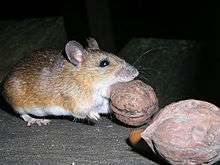Large Japanese field mouse
The large Japanese field mouse (Apodemus speciosus) is a nocturnal species of rodent in the family Muridae. It is endemic to Japan.
| Large Japanese field mouse | |
|---|---|
 | |
| Scientific classification | |
| Kingdom: | Animalia |
| Phylum: | Chordata |
| Class: | Mammalia |
| Order: | Rodentia |
| Family: | Muridae |
| Genus: | Apodemus |
| Species: | A. speciosus |
| Binomial name | |
| Apodemus speciosus (Temminck, 1844) | |
Distribution and habitat
The species appears to be present on all Japanese islands. It inhabits forests, grasslands, and cultivated fields, including rice paddies, at any altitude.[1] Though occupying the same broad ecological niche as A. argenteus, the two species prefer different microhabitats: A. argenteus prefers dense canopy, while A. speciosus prefers open secondary forests.[2]
Foraging behavior
Large Japanese field mice forage primarily at night, likely to avoid predation.[3] They are omnivores but mostly known to be seed-eating mice, particularly around autumn and winter, as the mice hoard acorns and walnuts, which comprise 13-100% of their food.[4][5] This makes them effective seed dispersers. Mast seeding can have serious effects on field mouse populations, including increases in overwinter survival, winter reproduction, and population density.[6]
Effects of light
Large Japanese field mice have been observed changing their typical foraging behavior in response to varying light conditions. In response to higher light intensity, A. speciosus significantly decreases time outside of the nest, length of excursions, and food eaten compared to periods of dark.[3] Additionally, the mice tend to carry food back to their nests during periods of light as opposed to eating away from the nest as they normally would in the dark.[3] These behavioral changes are thought to be an adaptation to help the mice avoid potential predators, avoiding, for example, well-lit areas on the ground as they forage at night. Differences in such changes in behavior allow for the fulfillment of specific niches, as is observed between A. speciosus and A. argenteus, which react to light differently because of their differing body size.[3]
Tannin selection
Many of the acorns and nuts consumed by this species have high tannin levels, making them highly toxic to rodents in high doses.[7] Large Japanese field mice display specific physiological and behavioral adaptations to deal with this toxicity. A. speciosus is able to acclimate to nuts with high tannin levels by secretion of specialized proteins and recruitment of bacteria to aid in digestion.[8] It also displays a proactive foraging preference for acorns with lower levels of tannin and related proteins.[9] These changes are evolutionarily adaptive by allowing the mice to deal with or avoid tannin consumption.
Learning behavior
A. speciosus, like many species of rodents, have shown a degree of learning in their feeding habits. Specifically, wood mice with previous experience eating walnuts are able to eat them more quickly, efficiently, and in greater quantities than mice that had not encountered hard-shelled walnuts.[10] Additionally, mice without previous experience are able to successfully learn more efficient foraging behavior within 14 days of conditioning, a strong indication that foraging behavior is not strictly genetically determined and that trial-and-error may be a contributing mechanism.[10] The behavior is also affected socially, as mice raised in specific environments forage in ways that mice in other environments may not. For example, large Japanese field mice raised in environments with more tannin-rich nuts show greater selectivity than those that do not.[9] Behavioral fluidity and the ability to quickly adapt to environments without the need for evolution, which would take many generations to become apparent, is key for the survival of the mice in varying environments.
References
- Kaneko, Y. & Ishii, N. (2008). "Apodemus speciosus". IUCN Red List of Threatened Species. 2008.CS1 maint: ref=harv (link)
- "Microhabitat Separation between Apodemus argenteus and A. speciosus in Northern Kyushu". Journal of the Mammalogical Society of Japan. 14 (6): 105–118. 1990.
- Sone, K (2002). "Changes in foraging behavior of two species of field mice, Apodemus speciosus Temminck and A. argenteus Temminck (Rodentia: Muridae), in the response to artificial illumination". Journal of Forest Research. 7 (1): 17–21. doi:10.1007/bf02762594.
- Tatsukawa, K.; Murakami, O. (1976). "On the food utilization of the Japanese wood mouse Apodemus speciosus (Mammalia: Muridae)". Physiology and Ecology Japan. 17: 133–144.
- Ota, K.; Abe, H.; Kobayashi, T.; Fujimaki, Y.; Higuchi, S.; Igarashi, B.; Kuwahata, T.; Maeda, M.; Ueda, M.; Takayasu, T. (1977). "A synecological study of murid rodents". Research Bulletins of the College Experiment Forests Hokkaido University.
- Watts, C. H. S. (1969). "The Regulation of Wood Mouse (Apodemus sylvaticus) Numbers in Wytham Woods". Journal of Animal Ecology. 38 (2): 285–304. doi:10.2307/2772. JSTOR 2772.
- Shimada, Takuya; Saitoh, Takashi (2003). "Negative Effects of Acorns on the Wood Mouse Apodemus speciosus". Population Ecology. 45 (1): 7–17. doi:10.1007/s10144-002-0134-4.
- Shimada, Takuya (24 February 2006). "Role of Tannin-Binding Salivary Proteins and TannaseProducing Bacteria in the Acclimation of the Japanese Wood Mouse to Acorn Tannins". Journal of Chemical Ecology. 32 (6): 1165–1180. doi:10.1007/s10886-006-9078-z. PMID 16770711.
- Takahashi, A.; Shimada, T. (2008). "Selective Consumption of Acorns by the Japanese Wood Mouse According to Tannin Content: A Behavioral Countermeasure Against Plant Secondary Metabolites". Ecological Research. 23 (6): 1033–1038. doi:10.1007/s11284-008-0473-5.
- Takechi, Reina; Tamuro, Noriko (2009). "Improved Walnut-Feeding Skills with Experience in Wood Mice, Apodemus speciosus". Journal of Ethology. 27 (1): 83–89. doi:10.1007/s10164-008-0087-y.
External links
| Wikimedia Commons has media related to Apodemus speciosus. |
- Musser, G.G.; Carleton, M.D. (2005). "Superfamily Muroidea". In Wilson, D.E.; Reeder, D.M (eds.). Mammal Species of the World: A Taxonomic and Geographic Reference (3rd ed.). Johns Hopkins University Press. pp. 894–1531. ISBN 978-0-8018-8221-0. OCLC 62265494.
